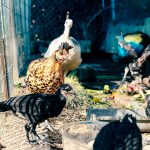Hawks and eagles are formidable predators that pose a significant threat to backyard chickens. These birds of prey are known for their keen eyesight, powerful talons, and swift hunting skills. In order to protect your flock, it’s crucial to be able to identify these raptors in your area.
Hawks are generally smaller than eagles, with long, narrow wings and a distinctive hooked beak. They are often seen soaring high in the sky, scanning the ground for potential prey. On the other hand, eagles are larger and have a characteristic white head and tail, with a wingspan that can reach up to 7 feet.
Both hawks and eagles are protected under the Migratory Bird Treaty Act, which means that it is illegal to harm or kill them without a permit. It’s important to familiarize yourself with the specific species of hawks and eagles that are native to your region. For example, in North America, you may encounter red-tailed hawks, Cooper’s hawks, or sharp-shinned hawks, all of which are known for preying on small mammals and birds.
Bald eagles and golden eagles are also common in certain areas and can pose a threat to chickens. By understanding the behavior and habits of these birds, you can take proactive measures to safeguard your flock from potential attacks.
Table of Contents
- 1 Creating a secure chicken coop: Tips for building a predator-proof enclosure
- 2 Utilizing scare tactics: Scarecrows, reflective objects, and other deterrents
- 3 Implementing predator control: Using dogs, netting, or fencing to keep hawks and eagles at bay
- 4 Providing alternative food sources: Attracting hawks and eagles to other prey in your area
- 5 Monitoring and supervision: Keeping a close eye on your chickens and their surroundings
- 6 Seeking professional help: Consulting with wildlife experts or bird control specialists
- 7 FAQs
- 7.1 What are some natural ways to keep hawks and eagles away from chickens?
- 7.2 What are some physical barriers that can be used to protect chickens from hawks and eagles?
- 7.3 Are there any predator deterrent devices that can be used to keep hawks and eagles away from chickens?
- 7.4 What should I do if I spot a hawk or eagle near my chicken coop?
- 7.5 Are there any legal methods for deterring hawks and eagles from chickens?
Key Takeaways
- Hawks and eagles can be identified by their size, shape, and behavior, and it’s important to know which species are present in your area.
- Building a secure chicken coop with strong materials, secure latches, and underground barriers can help protect your chickens from predators.
- Scare tactics such as scarecrows, reflective objects, and noise makers can help deter hawks and eagles from targeting your chickens.
- Implementing predator control measures like using dogs, netting, or fencing can help keep hawks and eagles away from your chickens.
- Providing alternative food sources for hawks and eagles, such as setting up feeding stations for small mammals, can help divert their attention away from your chickens.
- Regular monitoring and supervision of your chickens and their surroundings can help you spot potential threats and take action to protect them.
- Seeking professional help from wildlife experts or bird control specialists can provide valuable advice and assistance in managing hawks and eagles in your area.
Creating a secure chicken coop: Tips for building a predator-proof enclosure
Secure Materials and Roofing
Opt for sturdy wire mesh with small gaps to prevent raptors from reaching through and grabbing your chickens. A solid roof is also essential to prevent aerial attacks.
Additional Security Measures
Bury the wire mesh at least a foot into the ground to deter predators from digging underneath the enclosure. Secure latches and locks on doors and windows will further fortify your coop against potential intruders.
Deterrents and Safe Outdoor Spaces
Consider installing motion-activated lights or alarms to startle hawks and eagles if they approach the coop. Creating a secure run for your chickens to roam during the day, complete with a roof or netting to shield them from aerial threats, is another effective strategy. By taking these precautions, you can significantly reduce the risk of hawks and eagles targeting your chickens.
Utilizing scare tactics: Scarecrows, reflective objects, and other deterrents

Scare tactics can be an effective way to deter hawks and eagles from targeting your chickens. One popular method is to install scarecrows or decoys in the vicinity of your coop. These lifelike figures can create the illusion of human presence and may discourage raptors from approaching.
Additionally, hanging reflective objects such as CDs, aluminum foil strips, or mirrors around the coop can disorient and intimidate hawks and eagles, causing them to seek easier prey elsewhere. Another option is to use predator decoys, such as plastic owls or snakes, to create a sense of danger for hawks and eagles. These decoys can be strategically placed near the coop to instill fear in potential predators.
Some chicken owners have also found success in using noise deterrents, such as wind chimes, bells, or even radios set to loud talk shows or music. The unpredictable sounds can startle hawks and eagles, making them think twice about targeting your chickens.
Implementing predator control: Using dogs, netting, or fencing to keep hawks and eagles at bay
Implementing predator control measures is crucial for safeguarding your chickens from hawks and eagles. One effective method is to enlist the help of a livestock guardian dog, such as a Great Pyrenees or Anatolian Shepherd. These breeds are known for their protective instincts and can serve as a formidable deterrent against raptors.
By patrolling the perimeter of your property, these dogs can keep hawks and eagles at bay and alert you to any potential threats. Netting can also be a valuable tool for protecting your chickens from aerial attacks. By covering the top of your chicken run with strong, durable netting, you can create a barrier that prevents hawks and eagles from swooping down on your flock.
Additionally, installing fencing around your property can help deter raptors from entering your premises. Choose fencing that is at least 6 feet tall and angled outward at the top to make it more challenging for hawks and eagles to perch or land.
Providing alternative food sources: Attracting hawks and eagles to other prey in your area
One strategy for mitigating the risk of hawks and eagles targeting your chickens is to provide alternative food sources for these raptors. By attracting them to other prey in your area, you can reduce the likelihood of them hunting your flock. Consider setting up bird feeders or nesting boxes for small songbirds to draw hawks’ attention away from your chickens.
Additionally, creating habitat for rodents or rabbits can offer natural prey for hawks and eagles to hunt instead. Another approach is to establish a wildlife-friendly environment by planting native trees and shrubs that provide food and shelter for small mammals and birds. By promoting biodiversity in your surroundings, you can encourage hawks and eagles to focus on natural prey rather than domestic poultry.
It’s important to strike a balance between protecting your chickens and coexisting with local wildlife, and providing alternative food sources can help achieve this equilibrium.
Monitoring and supervision: Keeping a close eye on your chickens and their surroundings

Observe Your Flock
Take the time to observe your flock throughout the day, especially during periods when raptors are most active, such as early morning or late afternoon. Look for any unusual behavior or distress among your chickens, as this could indicate the presence of a predator nearby.
Install Security Cameras
Consider installing security cameras around your property to keep a constant watch on your coop and surrounding areas. This can provide valuable insight into any potential threats and allow you to take immediate action if hawks or eagles are spotted.
Stay Vigilant and Proactive
By staying vigilant and proactive in monitoring your chickens, you can better protect them from predatory birds. Regular monitoring and supervision can help you detect any signs of hawk or eagle activity and take prompt action to safeguard your flock.
Seeking professional help: Consulting with wildlife experts or bird control specialists
If you’re facing persistent challenges with hawks and eagles targeting your chickens, it may be beneficial to seek professional assistance from wildlife experts or bird control specialists. These professionals can offer valuable insights and guidance on how to effectively manage raptor predation in your area. They may be able to conduct a site assessment of your property and recommend specific strategies for deterring hawks and eagles.
In some cases, obtaining permits for non-lethal control methods, such as trapping or relocation, may be necessary to address ongoing issues with predatory birds. Wildlife experts can help navigate the legal requirements and ethical considerations associated with managing raptor predation. By consulting with professionals who specialize in bird control, you can gain access to expertise and resources that can help protect your chickens while respecting the natural behavior of hawks and eagles.
In conclusion, protecting backyard chickens from hawks and eagles requires a multi-faceted approach that encompasses understanding the behavior of these predators, fortifying chicken coops, implementing deterrents, utilizing predator control measures, providing alternative food sources, monitoring chicken activity, and seeking professional guidance when needed. By taking proactive steps to safeguard your flock from raptor predation, you can create a safer environment for your chickens while promoting coexistence with local wildlife.
If you’re looking for ways to protect your chickens from predators like hawks and eagles, you may also be interested in learning how to insulate a chicken coop to keep your birds safe and comfortable in all weather conditions. Check out this helpful article on how to insulate a chicken coop for more information on creating a secure and cozy environment for your feathered friends.
FAQs
What are some natural ways to keep hawks and eagles away from chickens?
Some natural ways to keep hawks and eagles away from chickens include using scare tactics such as hanging shiny objects, using noise makers, and having a rooster to alert the flock of danger. Additionally, providing cover for the chickens to hide under can also help deter birds of prey.
What are some physical barriers that can be used to protect chickens from hawks and eagles?
Physical barriers such as netting, wire mesh, and fencing can be used to protect chickens from hawks and eagles. These barriers can be installed over the chicken coop or run to prevent birds of prey from accessing the chickens.
Are there any predator deterrent devices that can be used to keep hawks and eagles away from chickens?
Yes, there are predator deterrent devices such as motion-activated sprinklers, predator decoys, and predator-proof enclosures that can be used to keep hawks and eagles away from chickens. These devices can startle and deter birds of prey from approaching the chickens.
What should I do if I spot a hawk or eagle near my chicken coop?
If you spot a hawk or eagle near your chicken coop, it’s important to take immediate action to protect your chickens. You can use scare tactics such as making loud noises, waving your arms, or using a whistle to scare the bird away. It’s also important to ensure that your chickens have access to cover and hiding spots.
Are there any legal methods for deterring hawks and eagles from chickens?
Yes, there are legal methods for deterring hawks and eagles from chickens. These methods include using scare tactics, physical barriers, and predator deterrent devices. It’s important to check local regulations and laws regarding the protection of birds of prey before implementing any deterrent methods.
Meet Walter, the feathered-friend fanatic of Florida! Nestled in the sunshine state, Walter struts through life with his feathered companions, clucking his way to happiness. With a coop that’s fancier than a five-star hotel, he’s the Don Juan of the chicken world. When he’s not teaching his hens to do the cha-cha, you’ll find him in a heated debate with his prized rooster, Sir Clucks-a-Lot. Walter’s poultry passion is no yolk; he’s the sunny-side-up guy you never knew you needed in your flock of friends!







